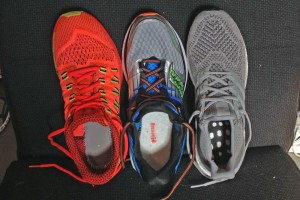We met with shoe designers from several companies at the Summer Outdoor Retailer trade show in Salt Lake City, Utah, from August 5-7. We heard about their new models coming out in the spring 2016 season. Here are some trends to look forward to in your running kicks.
Feel the Foam
Comfort is increasingly king in running shoes, and companies are trying new methods to improve the feel underfoot. If you lift the sock liner out of your shoe, you’ll see that the upper is stitched to a flat piece of fabric that is glued to the sole. This piece is called a “strobel board,” and is a big improvement over the rigid, cardboard-like boards that used to hold the upper to the sole. But, in order to hold the upper securely when it is being stretched over the last (a 3-D foot-shaped mold) during construction, the strobel needs to be made of a robust, non-stretch material. After being saturated in glue, this fabric layer still blocks some of the feel of high-tech squishy and bouncy material that makes up the midsole.
Nearly every company is now working to minimize the impact of the strobel. The simplest is to simply make the strobel thinner and more flexible, like Pearl Izumi is doing to let runners connect to their smooth-rolling eMotion soles. Adidas is cutting holes in the strobel, such as under the heel bone, to let you feel the cushioned bounce of the Boost material underneath. Not new is inserting foam between layers of fabric in the strobel or making the board itself out of a strip of foam, as Nike and New Balance do in much of their line. But now, some are actually building a midsole over the strobel. Saucony, for example is laying 3mm of their new Everun foam on top of the strobel to ensure you can feel its lively, force-dispersing properties.
Bottom line: Shoes get more comfortable and provide smoother cushioning.
Bring on the Bounce
Not long ago, we thought of shoes as either cushioned—providing comfort—or firm—giving a fast, responsive ride. Now, we’re increasingly seeing companies marketing nuances in the cushioned end of the spectrum, promising shoes that offer responsive, bouncy cushioning as well as those with soft, coddling rides. Adidas defined this new bouncy category with its Boost models, and now is inserting the game-changing material in all of their styles. While such materials don’t actually add energy to the propulsion of your stride, they may provide savings in the energy cost of landing and taking off, making you more efficient (adequate research has yet to prove this). In any event, these midsoles create a different sensation, one that many runners appreciate.
At Outdoor Retailer, we saw more companies looking to compete in this category. Saucony, for example, is introducing Everun foam, a new compound that doesn’t sink like traditional foams, thus it disperses forces and provides energy return, speeding your stride along. You’ll find it in their award-winning Triumph ISO and Hurricane ISO, both in a full-length layer directly under the foot (see above) and inserted in midsole on the outside of the heel where most people have the highest landing forces. New Balance also is touting a “bouncier” midsole compound in their Vazee Breath. Puma is expanding its Ignite line with full-length, rubbery midsoles that have excellent flex and cushion scores while delivering Super Ball-like rebound.
At the show, Brooks revealed a new categorization of its shoe lines based on nuances of feel, be that “Cushion me,” “Connect me,” “Energize me,” or “Propel me.” They also showed us a new shoe, the Neuro (see below), designed to epitomize the “Propel me,” fast, bouncy feel. Rather than a new foam they have created a snappy ride by encircling foam cushioning material in rubber rings that limit compression and enhance the bounce-back. HOKA, the max-cushioning king, is also giving a nod to turnover by making the midsole in its new, closer-to-the ground models softer in the heel for cushioning, and firmer in the forefoot to enhance the responsiveness.

Leave a Reply
You must be logged in to post a comment.